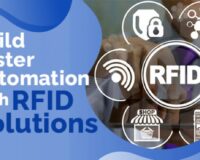Running a business in 2025 demands precision, automation, and traceability—and that’s where barcode labels and ribbons come into play. Whether you are managing inventory, handling logistics, or organizing retail products, these components serve as the backbone of modern product tracking.
In this blog, we will help you understand everything about barcode ribbons and labels, including their types, applications, and how they are used across different industries. We have kept the tone conversational and straightforward, making it ideal for beginners and seasoned professionals alike. Let us dive right into how these small but mighty tools keep big businesses organized.
🔍 What Are Barcode Labels & Ribbons?
Understanding Barcode Printing Materials and Media
When we talk about barcode printing, we usually refer to two essential components—barcode labels and barcode ribbons. Barcode labels are the actual sticky tags that are affixed to your products, containing scannable information. Barcode ribbons, on the other hand, are used in thermal transfer printers to transfer ink onto these labels.
Barcode ribbons come in three primary types:
- Wax ribbons – best for general use and paper-based labels
- Wax-resin ribbons – a more durable option, suitable for synthetic labels
- Resin ribbons – used for high-durability printing on plastic or polyester labels
Depending on your industry and environment (indoor, outdoor, chemical exposure), the right barcode ribbon roll can make a major difference in print longevity and clarity.
For instance, industrial barcode label printers often rely on resin ribbons for harsh conditions, while small businesses might use handheld barcode label printers with wax ribbons for daily operations.
We provides various solutions and guides to help you select the right barcode printing equipment for your industry.
🏷️ Types of Barcode Labels for Different Applications:
Choosing Between Reflective, Permanent, and 3M Barcode Labels
Not all labels are created equal. The barcode label you choose must align with the product surface, required scan distance, and environmental exposure.
Here are some common barcode label types:
- Permanent barcode labels: Ideal for long-term product labeling where the label should not be removed. These are commonly used in manufacturing and automotive industries.
- Reflective barcode labels: Used in large warehouses where barcodes are scanned from a distance. Their reflective surface enhances readability.
- 3M barcode labels: Known for durability, these labels are chemical-resistant and designed for industrial-grade use.
Businesses that operate in healthcare, shipping, and food packaging often have distinct labeling needs. For example, cold storage might require labels that withstand low temperatures without peeling or fading.
Whether you’re printing using a barcode and label printer or an industrial barcode label printer, your choice of label can directly affect scanning accuracy, shelf-life, and compliance with industry standards.
🖨️ Barcode Ribbons vs. Direct Thermal Printing
Comparing Print Methods and Ribbon Types for Longevity
One common question business owners ask is whether to use barcode ribbons or go for direct thermal printing. Here’s the breakdown:
Thermal transfer printing requires a barcode ribbon roll. The ribbon is heated and transfers ink to the label. This results in longer-lasting prints that resist heat, chemicals, and water.
Direct thermal printing, on the other hand, doesn’t use a ribbon. It prints directly onto heat-sensitive paper, which tends to fade over time and is not suitable for harsh environments.
When selecting your ribbon type, consider:
- Durability requirements
- Label material (paper, plastic, vinyl)
- Environmental conditions (sunlight, moisture, abrasion)
Using the right barcode ribbon not only improves print quality but also reduces printer wear and replacement costs. Many businesses working with barcode label printers opt for wax-resin blends to balance cost and durability.
For expert guidance, Mantaz Technologies can help recommend a solution tailored to your industry’s specific needs.
💸 Barcode Ribbon Price: What Influences the Cost?
Understanding Cost Factors of Barcode Labels and Ribbons
The barcode ribbon price can vary depending on several factors:
- Ribbon type (wax, wax-resin, resin)
- Length and width of the roll
- Printer compatibility
- Volume and usage frequency
While it might be tempting to go for the cheapest option, investing in high-quality barcode ribbon rolls ensures less printer downtime, higher scan accuracy, and better overall productivity.
Also, don’t forget to match the barcode labels and ribbons with your printer. For instance, a barcode and label printer used in a retail store might require different ribbons than one used in a manufacturing unit.
Look for deals from reputed suppliers and consider bulk purchases if your business has high-volume printing needs. Always factor in long-term performance, not just upfront cost.
Frequently Asked Questions (FAQs):
Q1. What is the difference between barcode ribbons and barcode labels?
Barcode ribbons are ink-based rolls used in thermal transfer printing, while barcode labels are the surfaces that carry the barcode printed by the ribbon.
Q2. What is the average barcode ribbon price?
Prices vary based on ribbon type and roll size. Wax ribbons are the most affordable, while resin ribbons cost more but last longer.
Q3. Can I use the same barcode ribbon roll for all printers?
Not always. Barcode ribbon rolls are often designed for specific printers. Always check compatibility with your barcode label printer.
Q4. Are permanent barcode labels waterproof?
Many permanent labels are water-resistant, especially when paired with the right ribbon. Resin ribbons work best for waterproof and chemical-resistant applications.
Q5. How do I generate barcode labels for my products?
You can generate them using barcode software paired with a barcode and label printer. Most industrial printers come with bundled software or APIs for automation.
Summary:
In 2025, efficiency and accuracy are non-negotiable for business operations. Barcode labels and ribbons continue to be a vital asset for industries across the board—from retail and logistics to healthcare and manufacturing.
By understanding the differences between label types, choosing the right barcode ribbon, and factoring in the environment and durability needs, you can dramatically improve product traceability and operational workflow.
Invest in quality. Print smarter. Label better. And when in doubt, consult experts like Mantaz Technologies to future-proof your labeling strategy.
Are you ready to streamline your barcode printing process with the right labels and ribbons? Let the experts guide you through choosing the best-fit barcode solutions for your business.
Whether you need help with industrial-grade label printers or affordable ribbon supplies, we are here to support your growth in 2025 and beyond.



